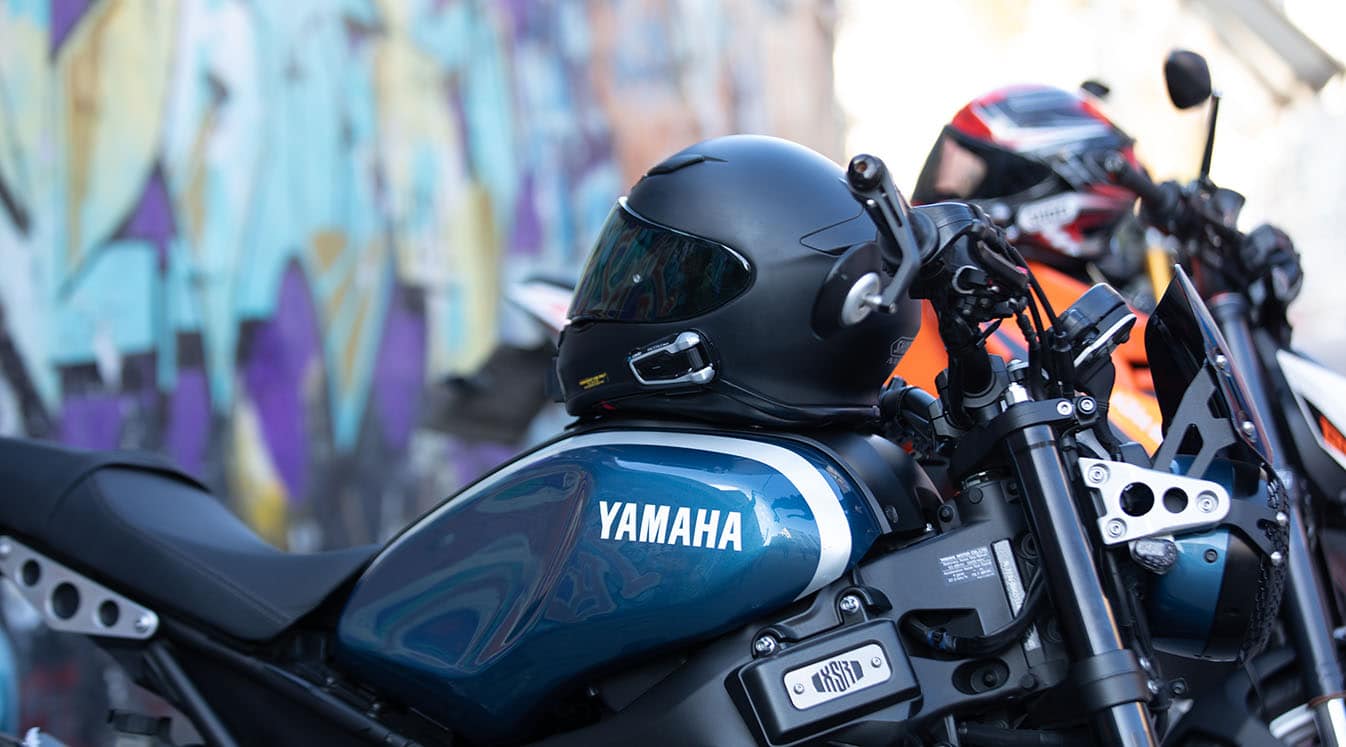What Is a Motorcycle Group?
Motorcycle groups come in all shapes and sizes. They serve all kinds of different needs and purposes in their respective communities. Riders may coalesce around their love of the open road or some type of shared experience, such as serving in the military, working as a firefighter or police officer or even going to college together. Some groups will enjoy the occasional group ride, while others have their own code, strict membership rules and even a clubhouse for conducting business.
You can usually spot a group by the patches they wear on their jackets and sleeves. There are generally three types of motorcycle groups, and each comes with its own patch design. Although these rules aren’t set in stone, one-patch designs are formally recognized by the American Motorcycle Association, two-patch designs usually denote casual biker clubs and three-patch designs refer to outlaw gangs.
You don’t have to wear a patch to be in a group, but it’s an easy way to tell other riders and drivers that you all belong to the same pack.
Some groups are harder to join than others. Like a fraternity, you might have to pass a certain test or prove your worth in order to earn your patch or place in the group, but this kind of behavior isn’t for everyone.
Shop Bike to Bike Communication Systems
At the end of the day, riding in a group is all about bringing people together and sharing your time together on the road. Life tends to be sweeter when other people are around. All you need is a group of like-minded riders with bikes, valid motorcycle licenses and the proper safety gear. It’s just that simple.
The Risks/Benefits of Sticking Together
You might ask yourself, “Why join a motorcycle group?” First off, it’s a great way to meet other people who enjoy riding just as much as you do. Beyond friendship, riding in groups comes with its fair share of pros and cons. On the one hand, joining a group gives you access to an enormous range of knowledge and experience that might otherwise take years to develop. Once you’re in the club, you can ask your fellow riders for tips on fixing and maintaining your bike while learning about new routes and trails to explore.
Riding in a group can also bring peace of mind, especially if you don’t have a lot of experience on the road. The other group members will be there to literally pick you up if you fall. They can help repair your bike on the scene or call for emergency assistance.
However, riding in groups takes some getting used to. Members tend to ride close together, which can make it difficult to stop and turn. You’ll need to learn to drive in unison to reduce the chances of collision. Formation riding can lead to all kinds of injuries, including bone and facial fractures, spinal cord injuries, puncture wounds and road rash from all that extra riding around. Having too many riders on the road can also be a hazard, especially on the highway or when navigating tight turns. Experts recommend having no more than five to seven riders on the road at the same time.
Riding in a group can also get you into trouble if you cruise through the wrong neighborhood. Avoid drawing too much attention to yourselves if you live in an area with high crime rates or gang violence.
Getting Started
Before you take off as a group, start by making sure everyone is on the same page. All members should be fully licensed and trained to operate a motorcycle. Everyone should also be wearing the proper safety gear, including gloves, goggles and a helmet (ideally full-face). As much as we all love a decked-out leather jacket, it’s best to wear high-visibility clothing when riding in groups, especially when riding in the snow, fog or rain.
Don’t assume every rider is the same. Some members may have different types of motorcycles. Keep these differences in mind when you’re on the road.
Make sure everyone is aware of the risks that come with lane sharing, left-hand turns and other accidents that tend to be common among groups.
Have everyone spend a few minutes looking over their bike to make sure it’s ready for the trip ahead. It’s always a good idea to bring along tools, oil and other necessities for making repairs on the road.
The group should have a clear route or destination in mind. Everyone should know where they’re going and how to get there.
When going off-road as a group, bring along additional safety gear and supplies, such as food, water, flashlight, compass, fire starter and a towing system for getting each other out of the mud/snow.
Creating a Safe Formation
As you get on the road, use these tips to keep everyone in the right position.
Every group should have a designated leader, or Road Captain. This person may vary from trip to trip, but this person is responsible for making sure the group gets to and from the destination as safely as possible. The leader is generally the most experienced/alert in the group. They will watch out for certain hazards in the road and communicate to the rest of the team using hand signals or wireless communication. The captain is also in charge of the route, including any planned breaks.
The captain should be at the front. They usually stick to the left third of the group’s chosen riding lane. This helps them see around the bend as they look out for traffic and unexpected obstacles.
After that, it’s best to use a staggered formation with riders in groups of two, but with one person slightly ahead and the other slightly behind. Riders usually go in order from most experienced to least, except for the tail rider. The most senior “officers” or riders usually go right behind the captain. Newbies typically go in the back where they may have to eat fumes throughout the day. The gear usually goes in the back as well. It’s that person’s job to keep up with the pack despite the extra weight.
The “tail rider” is considered the next most experienced rider after the captain. They are in charge of picking up the tail of the formation if anyone lags behind or gets into an accident. The tail needs to alert the rest of the team quickly to avoid getting left behind.
Response times are crucial when it comes to riding in a group. The leader needs to stay vigilant as they guide the group through various types of terrain, especially in off-road settings. From dead animals to cracked concrete and wayward branches, they should alert the group as soon as possible so everyone can change course at the right time.
Riders usually stay in pairs of two most of the time, but you may need to go single file if the lane gets too narrow. Pair up riders based on their experience level. A novice rider may be more comfortable staying close to a more seasoned pro who can give them tips along the way. Every rider will respond to the person in front of them, so pay attention to these relationships. If someone’s slow to respond, it could lead to some inter-member drama.
Re-forming can be tricky if someone peels away from the group. Leaving a gap in the formation can make it easy for a car to slip in between riders. The next person in the formation should move ahead to fill in the gap. Riders typically shouldn’t be passing each other on the road.
Safety Tips for Riding in Groups
Constant Communication: Nothing could be more important than your ability to communicate as a group. Things can change on a dime on and off the road, so everyone needs to be on the same page in real-time. Many groups rely on hand signals, but it usually takes a few seconds for the message to work its way through the group.
Use Bluetooth motorcycle speakers that fit inside your helmet to keep everyone connected throughout your trip. The speakers should produce clear audio so everyone can hear what the leader is saying.
Listening to instructions is one thing, but don’t forget to respond. Give every member a motorcycle Bluetooth headset so they can chime in from time to time. Someone may need emergency assistance, directions or even a quick trip to the bathroom.
Traveling as a group wouldn’t be the same if you couldn’t talk to each other along the way. You can share your experiences with each other as they happen in real-time.
Even with Bluetooth technology, it’s always good to brush up on your hand signals in case your device goes dead during the trip.
Shop Bluetooth Motorcycle Headsets and Speakers
Keep Your Distance: Stay close, but not too close. The Motorcycle Safety Foundation recommends maintaining at least a two-second gap between each rider. Using a staggered formation, the rider on the left will need to stay two seconds away from the next rider on the left, with one second in between them and the rider on the right. Newer riders may want to increase their stopping distance in case they need more time to respond.
Stay Flexible: Your formation shouldn’t be set in stone. Riders should adjust their position and following distance based on what’s going on around them. For example, cyclists in bad weather may leave less room on the road, so be prepared to go into a single-file formation when needed.

Bring a Back-Up: Having more riders won’t necessarily solve your problem if you get stranded or don’t know where you’re going. Make sure you have at least one fully charged cell phone, GPS or radio for calling for help. Bring along a paper map of the local area to avoid getting lost in case your tech bites the dust. It’s also a good idea to bring along a solar charger for some added electricity.
Passing Vehicles: Passing cars on the road can be dangerous when you’re in a group. It’s usually best to let the person get out of your way instead of trying to zoom ahead of them, but sometimes slow drivers just won’t budge. It’s better to pass the person one at a time. The leader should signal to the rest of the group that they are going around. Every rider should look out for oncoming traffic before going around the driver. It may take several minutes for everyone in the group to safely make it around the vehicle.
Stay Responsible: Riding in groups can lead to some – shall we say – juvenile behavior, including showboating, racing and other shenanigans. Avoid the temptation to show off when riding in a group. You can always pull off onto a quiet road or empty parking lot if you want to show off some of your tricks. Group riding is stressful enough, so don’t make it any harder on yourself. Remind your fellow riders to keep their cool on the road. If you see someone goofing off, say something right away.
Riding in a group can be one of the best parts of owning a motorcycle. With this information in tow, you should be ready to bring your fellow riders together for the ultimate road trip. Stay safe and enjoy the ride!









